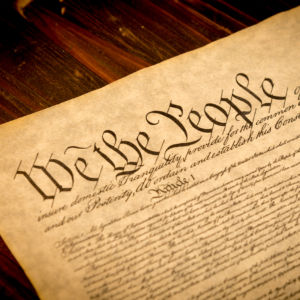Editor’s Note: For another viewpoint, see POINT: Congress Must Make Constitution’s Promise a Reality.
In the period leading up to the Constitution’s bicentennial, the late constitutional scholar Walter Berns was asked to give an address on the Constitution in a Latin American country. After delivering his remarks, a clearly agitated man directed a question to the event’s sponsors: “Why,” he asked, “was this American giving a lecture to us? After all, our country has had numerous constitutions, while the U.S. has had only one!”
Humor aside, the United States has had in fact two constitutions, the Articles of Confederation (1781) and the Constitution (1788). Nevertheless, the underlying point remains the same: There has been remarkable stability in the country’s basic governing structure. Why?
The answer starts with the move from the Articles to the Constitution. Not satisfied with how the young republic was functioning, the founding generation designed a new structure, which in their view, would better protect basic rights and promote sounder policies. The goal, as they repeatedly put it, was to create a national government that would help make Americans prosperous at home and respected abroad — a country strong enough that it could control its own destiny in a monarchic world not likely to be friendly to its revolutionary republicanism.
While there have been struggles and setbacks in meeting those goals — most obviously and damagingly in the case of slavery and civil rights for African Americans — the reality is America has become a prosperous nation and remains the bulwark of the world’s liberal order. As a Marxist might say, “This hasn’t happened by accident, comrade.”
It’s true much of this progress is owed to the character and ingenuity of individual citizens. But, as we have seen throughout history, poorly constructed governing institutions can inhibit such virtues from being properly promoted or even exercised.
This is not to say the United States does not face political problems at home. “Domestic tranquility,” as the Constitution’s Preamble puts it, is far from ensured. However, the question that needs to be asked is whether this is a problem largely attributable to the Constitution or rather to the political system that overlays it.
Take, for example, the state of America’s political parties. Parties were originally intended to ensure candidates were governed by a set of principles articulated in a platform and were held to that standard and moderated by it once elected to office. Today, candidates regularly appeal to a minority in open primaries, adopting policy positions that polarize, rather than moderate, our politics.
This feeds into our governing institutions, particularly the Congress and the presidency. Instead of elected officials incentivized to develop a national consensus to deal with the issues the country faces, and to run on their record of having addressed problems, they are driven to promote an agenda that can only be put in place when one party controls both houses of Congress and the Oval Office. It’s the electoral equivalent of the children’s game of “capture the flag.” It’s all or nothing politics, with the result that senators filibuster to stop the other side from enacting legislation, congressmen ignore their own budget rules to pass massive spending bills, and presidents use executive orders to enact policies that should be the prerogative of the Congress to decide on.
None of this is inevitable — nor is it tied directly to the Constitution. Over the years, the political parties have changed how candidates are chosen. Over the years, Congress has changed how it operates internally, giving more sway to leadership but less to the more deliberative work of the committees, for example. Over the years, presidents have come to see themselves as “running” the country, in charge of everything from the economy to the health and safety of the smallest communities. It’s a mandate they can’t possibly keep, and inevitably leads to frustration on the part of the country at large.
Such frustration inevitably leads some to argue for this or that major change to our governing structures, such as abolishing the Electoral College. Of course, we should never dismiss out of hand the possibility that a change in the Constitution might be for the better. After all, there have been 27 amendments to that document. Yet before heading down a path whose long-term consequences cannot be fully known, it would be wiser first to consider what more modest but nonetheless important changes can be made to the political system, without tampering with a constitution that has served the country so demonstrably well for more than two centuries.

